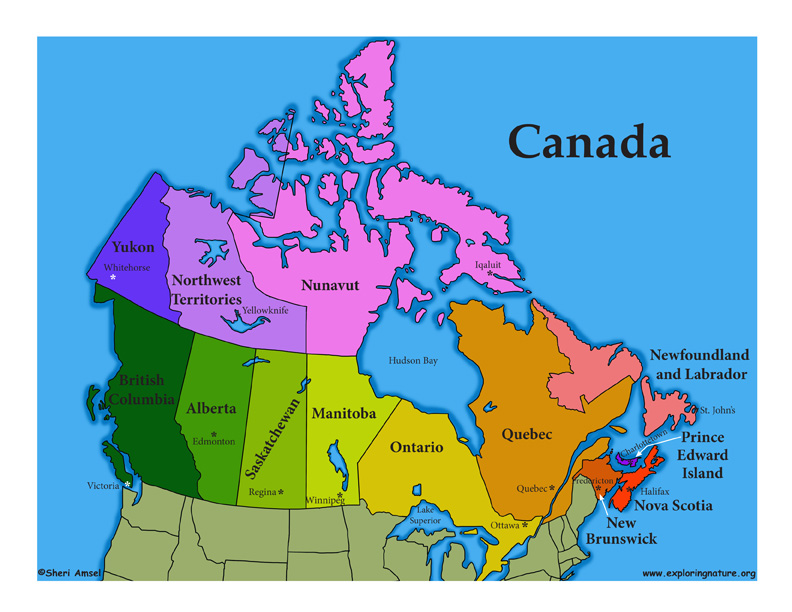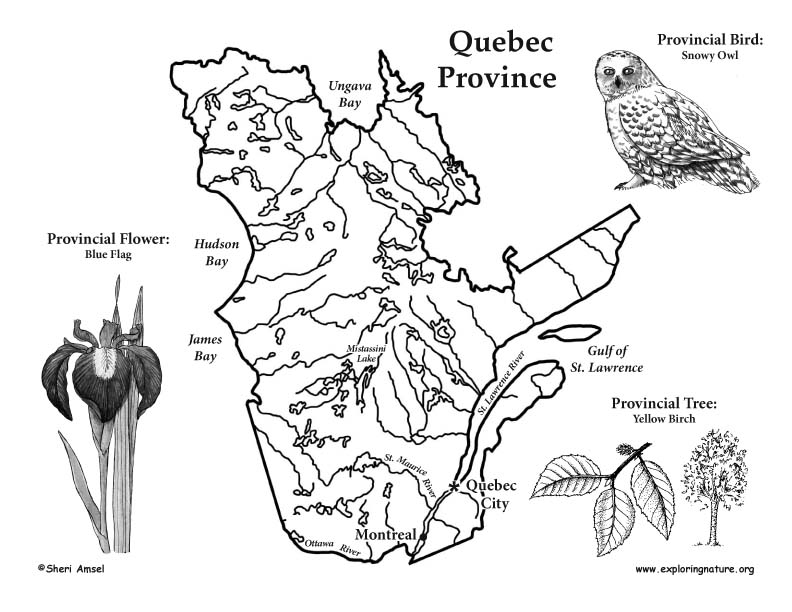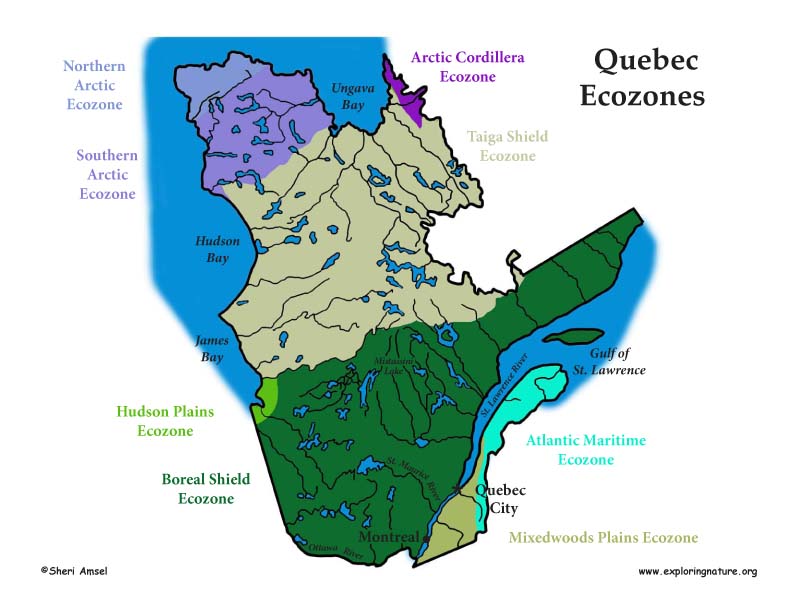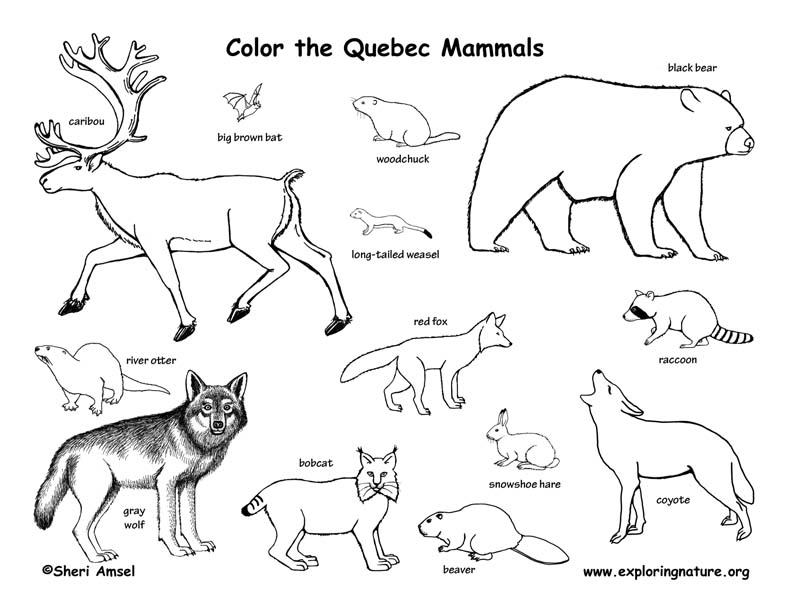

The province of Quebec is found in eastern Canada and is the country's largest Province (second only to Nunavut Territory). It makes up the eastern shore of Hudson Bay and James Bay, the southern shore of the Hudson Strait and Ungava Bay, the northern shore of the Gulf of St. Lawrence and surrounds much of the St. Lawrence River. It shares a border with Ontario, Newfoundland and Labrador, New Brunswick and the U.S. Quebec is the second most populated Province after Ontario with most of its people living in the southeast along the St. Lawrence River in Montreal and Quebec City - the Province capital. It is a French-speaking Province.
Quebec has tundra, taiga, temperate and boreal forests, and wetlands - including thousands of lakes and rivers. These natural habitats are broken down in the following way: 24% tundra, 20% taiga, 27% boreal forest, 11.5 % mixed forest, and 6.6% deciduous forest.
Quebec has a massive boreal forest of almost 300 million acres (63,322 square miles or 1.2 million square km). Most of it (about 75%) is undeveloped, making it important habitat for wildlife like woodland and barren ground caribou, Canada lynx, gray wolf and moose. Mixed in with this great forest of mostly balsam fir and black spruce are aspen, paper birch, and white spruce. There are also rivers, lakes, ponds, bogs and peatland that are vital habitat to as many as 500-million breeding birds (estimates are 180 species of birds). 25% of Canada’s woodland caribou live here.
The whole province is rich with waterways including the St. Lawrence River which is large enough to navigate trans-Atlantic boats to Montreal (almost 1,000 miles upriver from the ocean) when not frozen. Other large rivers include the Ottawa, St. Maurice, Richelieu, and Saguenay Rivers. Quebec has thousands of lakes - the largest is Mistassini Lake which measures 537,600 acres (840 square miles or 2,175 square km).
Quebec Province has been broken down by scientists into Ecozones – Northern Arctic, Southern Arctic, Hudson Plains, Taiga Shield, Boreal Shield, Mixedwood Plains and Atlantic Maritime Ecozones.
The Northern Arctic Ecozone makes up the northwestern corner of Quebec. This ecozone is the coldest, driest region of Quebec (and Canada) – often called an arctic desert. The permafrost only thaws on the surface during the short summer. This ecozone is a treeless plain with some stunted trees and shrubs, sedges, moss, and low-lying plants. Animals must be well-adapted for survival in these extreme conditions. Some include mammals like: polar bear, wolverine, musk ox, arctic wolf, arctic fox, weasel, arctic hare, snowshoe hare, and barren-ground caribou. There are also birds like the snowy owl, gyrfalcon, snow goose, and king eider. No reptiles or amphibians live in this region.
The Southern Arctic Ecozone runs in a band just south of the Northern Arctic Ecozone. This region – also called the Barren Lands, is a treeless plain with very long, very cold and dark winters. Because of the permafrost, the ground is wet throughout the short, cool summer and grows only dwarf trees and shrubs, heath, moss, sedges and lichens. As in the Northern Arctic Ecozone, animals here must also be well-adapted for survival like the polar bear, grizzly and black bear, wolverine, musk ox, arctic wolf, arctic fox and red fox, weasel, arctic hare, snowshoe hare, and barren-ground and woodland caribou.
The Eastern Taiga Shield Ecozone is a flat, wet region of subarctic shrub tundra (in the north) and boreal forest (in the south) with long, cold winters. It acts as the transition between the Arctic and boreal forests and is dotted with millions of lakes left by the retreat of the glaciers. The lakes and bogs make it a popular breeding ground for waterfowl. The forest includes: black and white spruce, jack pine, green alder, paper, white and dwarf birch, tamarack, balsam fir, quaking aspen, and balsam poplar. The region supports animals that can tolerate subarctic conditions, including black, grizzly and polar bear, wolf, lynx, moose, barren-ground and woodland caribou, coyote, weasel, wolverine, river otter, red and arctic fox, muskrat, marten, mink, beaver, vole, red squirrel, and snowshoe hare.
In the northeastern corner of Quebec, along the Ungava Bay, is a sliver of Arctic Cordilla Ecozone. This is a region of jutting rocks, mountain chains, polar ice fields and glaciers along the coast of deep fiords. It is a beautiful region with an extreme climate. The few hardy plants and lichens are the only food source for the region's two herbivores - the musk ox and barren-ground caribou. Other mammals include polar bear, arctic wolf, arctic fox, arctic hare, weasels and lemmings.
Along Hudson Bay, there is a small pocket of Hudson Plains Ecozone. This region is a lowland plain dominated by wetlands – peat bogs and fens and with coastal beaches and mudflats. This is vital habitat for migrating birds. There is a permafrost and long, very cold winters. Summers are short and cool. Polar bears frequent the coastal region as do breeding waterfowl. Woodland caribou, moose, black bear, fisher, marten, and arctic fox roam the inland wetlands.
The Boreal Shield Ecozone is a huge ecozone that stretches all across Canada with rolling hills covered in boreal forest. Millions of lakes were left by the retreat of the glaciers. These, along with with its abundant bogs and fens found throughout the region, make it a popular breeding ground for waterfowl. The forests here include: black and white spruce, jack pine, green alder, paper, white and dwarf birch, tamarack, balsam fir, quaking aspen, and balsam poplar. The region supports black bear, wolf, lynx, moose, barren-ground and woodland caribou, coyote, weasel, wolverine, river otter, red and arctic fox, muskrat, marten, mink, beaver, voles, red squirrels, and snowshoe hare.
South of the Boreal Shield is a small region of Mixedwood Plains Ecozone. It contains mixed and hardwood forests, wetlands and some prairie and is considered the northern end of the eastern temperate deciduous forest with trees like: eastern white and red pines, eastern hemlock, yellow birch, sugar maple, red oak, basswood and elm. The region has a rich diversity of wetlands adjacent to the Great Lakes and both the Ottawa and St. Lawrence Rivers - though many have been damaged or destroyed by development. Wildlife here includes: white-tailed deer, coyote, weasel, red fox, badger, raccoon, striped skunk, muskrat, beaver, woodchuck, gray squirrel and snowshoe hare. Though this is a small portion of the Quebec Provence, the Mixed Plains Ecozone has the most people.
The Atlantic Maritime Ecozone in Quebec is found on the Gaspé Peninsula - the southern shores of the St. Lawrence Seaway where it borders with New Brunswick. This region has mixed forests (Acadian Forest) and sand dunes along the coast. Mammals of this ecozone include: black bear, Canada lynx, bobcat, moose, white-tail deer, raccoon, red fox, otter, coyote, fisher, musket, mink, beaver, snowshoe hare, porcupine, chipmunk and squirrels.
Mammals:
Bat (Big Brown) - Eptesicus fuscus
Bat (Eastern Red) - Lasiurus borealis
Bat (Eastern Pipistrelle) - Pipistrellus subflavus
Bat (Eastern Small-footed) - Myotis leibii
Bat (Hoary) - Lasiurus cinereus
Bat (Keen) - Myotis keenii
Bat (Little Brown Myotis) - Myotis lucifugus
Bat (Silver-haired) - Lasionycteris noctivagans
Bear (Black) - Ursus americanus
Bear (Polar) - Ursus maritimus
Beaver - Castor canadensis
Bobcat - Lynx rufus
Caribou (Woodland) - Rangifer tarandus
Chipmunk (Eastern) - Tamias striatus
Chipmunk (Least) - Tamias minimus
Coyote - Canis latrans
Deer (White-tailed) - Odocoileus virginianus
Fisher - Martes pennanti
Fox (Arctic) - Alopex lagopus
Fox (Gray) - Urocyon cinereoargenteus
Fox (Red) - Vulpes vulpes
Hare (Arctic) - Lepus arcticus
Hare (Snowshoe) - Lepus americanus
Lemming (Hudson Bay Collared) - Dicrostonyx hudsonicus
Lemming (Northern Bog) - Synaptomys borealis
Lemming (Southern Bog) - Synaptomys cooperi
Lynx (Canadian) - Lynx canadensis
Marten (American) - Martes americana
Mink (American) - Neovison vison
Mole (Hairy-tailed) - Parascalops breweri
Mole (Star-nosed) - Condylura cristata
Moose - Alces alces
Mountain Lion - Felis concolor cougar
Mouse (Deer) - Peromyscus maniculatus
Mouse (House) - Mus musculus
Mouse (Meadow Jumping) - Zapus hudsonius
Mouse (White-footed) - Peromyscus leucopus
Mouse (Woodland Jumping) - Napaeozapus insignis
Muskrat - Ondatra zibethicus
Otter (River) - Lontra canadensis
Porcupine - Erethizon dorsatum
Rabbit (Eastern Cottontail) - Sylvilagus floridanus
Rabbit (Eastern New England) - Sylvilagus transitionalis
Raccoon - Procyon lotor
Rat (Norway) - Rattus norvegicus
Shrew (Arctic) - Sorex arcticus
Shrew (Gaspe) - Sorex gaspensis
Shrew (Long-tailed) - Sorex dispar
Shrew (Masked) - Sorex cinereus
Shrew (Northern Water) - Sorex palustris
Shrew (Pygmy) - Microsorex hoyi
Shrew (Short-tailed) - Blarina brevicauda
Shrew (Smoky) - Sorex fumeus
Skunk (Striped) - Mephitis mephitis
Squirrel (Eastern Gray) - Sciurus carolinensis
Squirrel (Northern Flying) - Glaucomys sabrinus
Squirrel (Red) - Tamiasciurus hudsonicus
Squirrel (Southern Flying) - Glaucomys volans
Vole (Boreal Red-backed) - Clethrionomys gapperi
Vole (Meadow) - Microtus pennsylvanicus
Vole (Mountain) - Phenacomys intermedius
Vole (Woodland) - Microtus pinetorum
Vole (Yellownose) - Microtus chrotorrhinus
Weasel (Least) - Mustela nivalis
Weasel (Long-tailed) - Mustela frenata
Weasel (Short-tailed or Ermine) - Mustela erminea
Wolf (Gray) - Canis lupus
Wolverine - Gulo gulo
Woodchuck - Marmota monax
For more details about Quebec's mammals: LINK
Birds:
albatross (yellow-nosed)
avocet (American)
bittern (American)
bittern (least)
blackbird (Brewer's)
blackbird (red-winged)
blackbird (rusty)
blackbird (yellow-headed)
bluebird (eastern)
bluebird (mountain)
bobolink
bobwhite (northern)
brambling
bunting (indigo)
bunting (lark)
bunting (lazuli)
bunting (painted)
bunting (snow)
cardinal (northern)
catbird (gray)
chat (yellow-breasted)
chickadee (black-capped)
chickadee (boreal)
Chuck-will's-widow
coot (American)
coot (Eurasian)
cormorant (double-crested)
cormorant (great)
cowbird (brown-headed)
crane (common)
crane (sandhill)
crane (whooping)
creeper (brown)
crossbill (red)
crossbill (white-winged)
crow (American)
crow (fish)
cuckoo (black-billed)
cuckoo (yellow-billed)
curlew (Eskimo)
curlew (Eurasian)
dickcissel
dove (Eurasian collared)
dove (mourning)
dove (rock)
dove (white-winged)
dovekie
dowitcher (long-billed)
dowitcher (short-billed)
duck (American black)
duck (American widgeon)
duck (Barrow's goldeneye)
duck (black-bellied whistling)
duck (black scoter)
duck (blue-winged teal)
duck (bufflehead)
duck (canvasback)
duck (cinnamon teal)
duck (common eider)
duck (common goldeneye)
duck (Eurasian widgeon)
duck (fulvous whistling)
duck (gadwall)
duck (garganey)
duck (greater scaup)
duck (green-winged teal)
duck (harlequin)
duck (king eider)
duck (lesser scaup)
duck (long-tailed or oldsquaw)
duck (mallard)
duck (northern pintail)
duck (northern shoveler)
duck (white-cheeked shoveler)
duck (redhead)
duck (ring-necked)
duck (ruddy)
duck (Stellar's eider)
duck (surf scoter)
duck (taiga bean)
duck (tufted)
duck (tundra bean)
duck (white-winged scoter)
duck (wood)
dunlin
eagle (bald)
eagle (golden)
egret (cattle)
egret (great)
egret (little)
egret (snowy)
falcon (gyrfalcon)
falcon (peregrine)
fieldfare
finch (gray-crowned rosy-)
finch (house)
finch (purple)
flicker (northern)
frigatebird (magnificent)
flycatcher (Acadian)
flycatcher (alder)
flycatcher (ash-throated)
flycatcher (fork-tailed)
flycatcher (great-crested)
flycatcher (least)
flycatcher (olive-sided)
flycatcher (scissor-tailed)
flycatcher (vermillion)
flycatcher (willow)
flycatcher (yellow-bellied)
fulmar (northern)
gallinule (common)
gallinule (purple)
gannet (northern)
gnatcatcher (blue-gray)
godwit (black-tailed)
godwit (Hudsonian)
godwit (marbled)
goldfinch (American)
goose (barnacle)
goose (brant)
goose (cackling)
goose (Canada)
goose (graylag)
goose (great white-fronted)
goose (pink-footed)
goose (Ross's)
goose (snow)
grackle (common)
grèbe (eared)
grèbe (horned)
grèbe (pied-billed)
grèbe (red-necked)
grèbe (western)
greenshank (common)
grosbeak (black-headed)
grosbeak (blue)
grosbeak (evening)
grosbeak (pine)
grosbeak (rose-breasted)
grouse (ruffed)
grouse (sharp-tailed)
grouse (spruce)
guillemot (black)
gull (black-headed)
gull (Bonaparte’s)
gull (California)
gull (Franklin's)
gull (glaucous)
gull (great black-backed)
gull (herring)
gull (Iceland)
gull (ivory)
gull (laughing)
gull (lesser black-backed)
gull (little)
gull (mew)
gull (ring-billed)
gull (Ross's)
gull (Sabine's)
gull (slaty-backed)
gull (Thayer's)
gull (western)
gull (yellow-legged)
harrier (northern)
hawk (broad-winged)
hawk (Cooper's)
hawk (northern goshawk)
hawk (red-shouldered)
hawk (red-tailed)
hawk (rough-legged)
hawk (sharp-shinned)
hawk (Swainson's)
heron (black-crowned night)
heron (great blue)
heron (green)
heron (little blue)
heron (tricolored)
heron (yellow-crowned night)
hummingbird (Anna's)
hummingbird (green violetear)
hummingbird (ruby-throated)
hummingbird (rufous)
ibis (glossy)
ibis (white)
ibis (white-faced)
jackdaw (Eurasian)
jaeger (long-tailed)
jaeger (parasitic)
jaeger (pomarine)
jay (blue)
jay (gray)
jay (Steller's)
junco (dark-eyed)
kestrel (American)
killdeer
kingbird (eastern)
kingbird (gray)
kingbird (tropical)
kingbird (western)
kingfisher (belted)
kinglet (golden-crowned)
kinglet (ruby-crowned)
kite (Mississippi)
kite (swallow-tailed)
kittiwake (black-legged)
knot (red)
lapwing (northern)
lark (horned)
longspur (Lapland)
longspur (McCown's)
longspur (Smith's)
loon (common)
loon (Pacific)
loon (red-throated)
loon (yellow-billed)
magpie (black-billed)
martin (purple)
meadowlark (eastern)
meadowlark (western)
merganser (common)
merganser (hooded)
merganser (red-breasted)
merlin
mockingbird (northern)
murre (common)
murre (thick-billed)
murrelet (ancient)
murrelet (long-billed)
nighthawk (common)
nuthatch (red-breasted)
nuthatch (white-breasted)
oriole (Baltimore)
oriole (Bullock's)
oriole (hooded)
oriole (orchard)
osprey
ovenbird
owl (barn)
owl (barred)
owl (boreal)
owl (burrowing)
owl (great gray)
owl (great horned)
owl (eastern screech)
owl (long-eared)
owl (northern hawk)
owl (northern saw-whet)
owl (short-eared)
owl (snowy)
oystercatcher (American)
partridge (gray)
parula (northern)
pelican (American white)
pelican (brown)
pewee (eastern wood)
pewee (western wood)
phalarope (red)
phalarope (red-necked)
phalarope (Wilson's)
pheasant (ring-necked)
phoebe (eastern)
phoebe (Say's)
pigeon (band-tailed)
pipit (American)
plover (American golden)
plover (black-bellied)
plover (common ringed)
plover (European)
plover (piping)
plover (semipalmated)
plover (Wilson's)
ptarmigan (rock)
ptarmigan (willow)
puffin (Atlantic)
rail (clapper)
rail (king)
rail (sora)
rail (Virginia)
rail (yellow)
raven (common)
razorbill
redpoll (common)
redpoll (hoary)
redstart (American)
redwing
robin (American)
ruff
sanderling
sandpiper (Baird's)
sandpiper (buff-breasted)
sandpiper (curlew)
sandpiper (least)
sandpiper (pectoral)
sandpiper (purple)
sandpiper (semipalmated)
sandpiper (sharp-tailed)
sandpiper (solitary)
sandpiper (spotted)
sandpiper (stilt)
sandpiper (upland)
sandpiper (western)
sandpiper (white-rumped)
sapsucker (yellow-bellied)
shearwater (Cory's)
shearwater (great)
shearwater (manx)
shearwater (sooty)
shrike (loggerhead)
shrike (northern)
siskin (Eurasian)
siskin (pine)
skimmer (black)
skua (great)
skua (south polar)
solitaire (Townsend's)
sparrow (American tree)
sparrow (black-throated)
sparrow (chipping)
sparrow (clay-colored)
sparrow (field)
sparrow (fox)
sparrow (grasshopper)
sparrow (Henslow's)
sparrow (lark)
sparrow (Le Conte's)
sparrow (Lincoln's)
sparrow (Nelson's)
sparrow (Savannah)
sparrow (seaside)
sparrow (song)
sparrow (swamp)
sparrow (vesper)
sparrow (white-crowned)
sparrow (white-throated)
starling
stilt (black-necked)
stint (red-necked)
stork (wood)
storm-petrel (Leach's)
storm-petrel (Wilson's)
swallow (bank)
swallow (barn)
swallow (cave)
swallow (cliff)
swallow (northern rough-winged)
swallow (tree)
swan (mute)
swan (trumpeter)
swan (tundra)
swan (whooper)
swift (chimney)
tanager (hepatic)
tanager (scarlet)
tanager (summer)
tanager (western)
tern (Arctic)
tern (black)
tern (Caspian)
tern (common)
tern (Forster's)
tern (gull-billed)
tern (least)
tern (roseate)
tern (royal)
tern (sandwich)
tern (sooty)
tern (white-winged)
thrasher (brown)
thrush (Biacknell's)
thrush (gray-cheeked)
thrush (hermit)
thrush (Swainson's)
thrush (varied)
thrush (wood)
titmouse (tufted)
towhee (eastern)
towhee (green-tailed)
towhee (spotted)
turkey (wild)
turnstone (ruddy)
veery
vireo (black-capped)
vireo (blue-headed)
vireo (Cassin's)
vireo (Philadelphia)
vireo (plumbeous)
vireo (red-eyed)
vireo (white-eyed)
vireo (warbling)
vireo (yellow-green)
vireo (yellow-throated)
vulture (black)
vulture (turkey)
wagtail (white)
warbler (bay-breasted)
warbler (blackburnian)
warbler (blackpoll)
warbler (black-and-white)
warbler (black-throated blue)
warbler (black-throated gray)
warbler (black-throated green)
warbler (blue-winged)
warbler (Canada)
warbler (Cape May)
warbler (cerulean)
warbler (chestnut-sided)
warbler (Connecticut)
warbler (golden-winged)
warbler (hermit)
warbler (hooded)
warbler (Kentucky)
warbler (Kirkland's)
warbler (magnolia)
warbler (mourning)
warbler (Nashville)
warbler (orange-crowned)
warbler (palm)
warbler (pine)
warbler (prairie)
warbler (prothonotary)
warbler (Swainson's)
warbler (Tennessee)
warbler (Townsend's)
warbler (Virginia)
warbler (Wilson's)
warbler (worm-eating)
warbler (yellow)
warbler (yellow-rumped)
warbler (yellow-throated)
waterthrush (Louisiana)
waterthrush (northern)
waxwing (Bohemian)
waxwing (cedar)
wheatear (northern)
whimbrel
whip-poor-will (eastern)
willet
woodcock (American)
woodpecker (American three-toed)
woodpecker (black-backed)
woodpecker (downy)
woodpecker (hairy)
woodpecker (pileated)
woodpecker (red-bellied)
woodpecker (red-headed)
woodpecker (yellow-bellied)
wren (Bewick's)
wren (Carolina)
wren (house)
wren (marsh)
wren (sedge)
wren (winter)
yellowlegs (greater)
yellowlegs (lesser)
For more details about Quebec's birds: LINK
Amphibians:
Bullfrog (American) - Lithobates catesbeianus or Rana catesbeiana
Frog (Boreal Chorus) - Pseudacris maculate
Frog (Green) - Lithobates clamitans
Frog (Mink) - Lithobates septentrionalis
Frog (Northern Leopard) - Rana pipiens
Frog (Pickerel) - Lithobates palustris or Rana palustris
Spring Peeper (Northern) - Pseudacris crucifer
Frog (Western Chorus) - Pseudacris triseriata
Frog (Wood) - Lithobates sylvaticus
Salamander (Blue-spotted) - Ambystoma laterale
Salamander (Eastern Newt) - Notophthalmus viridescens
Salamander (Eastern Red-backed) - Plethodon cinereus
Salamander (Four-toed) - Hemidactylium scutatum
Salamander (Mountain Dusky) - Desmognathus ocrophaeus
Salamander (Mudpuppy) - Necturus maculosus
Salamander (Northern Dusky) - Desmognathus fuscus
Salamander (Northern Two-lined) - Eurycea bislineata
Salamander (Spring) - Gyrinophilus porphyriticus
Salamander (Yellow-spotted) - Ambystoma maculatum
Toad (American) - Anaxyrus americanus
Treefrog (Gray) - Hyla versicolor
Reptiles:
Snake (DeKay's Brown) - Storeria dekayi
Snake (Eastern Garter) - Thamnophis sirtalis
Snake (Milk) - Lampropeltis triangulum
Snake (Northern Water) - Nerodia sipedon
Snake (Red-bellied) - Storeria occipitomaculata
Snake (Ringneck) - Diadophis punctatus
Snake (Smooth Green) - Opheodrys vernalis
Turtle (Blanding's) - Emydoidea blandingi
Turtle (Eastern Musk) - Sternotherus odoratus
Turtle (Northern Map) - Graptemys geographica
Turtle (Painted) - Chrysemys picta
Turtle (Snapping) - Chelydra serpentina
Turtle (Spiny Softshell) - Apalone spinifera
Turtle (Spotted) - Clemmys guttata
Turtle (Wood) - Clemmys insculpta
For more details about Quebec's amphibians and reptiles: LINK
Wild Science Workbook
Activities that Bridge Outdoor Exploration with Classroom Science
The activities in Wild Science will integrate outdoor exploration with the understanding and appreciation of science and environmental issues.
Using Wild Science as a guide, we invite you to rediscover your sense of wonder about the natural world and share it with the children you know.
When you research information you must cite the reference. Citing for websites is different from citing from books, magazines and periodicals. The style of citing shown here is from the MLA Style Citations (Modern Language Association).
When citing a WEBSITE the general format is as follows.
Author Last Name, First Name(s). "Title: Subtitle of Part of Web Page, if appropriate." Title: Subtitle: Section of Page if appropriate. Sponsoring/Publishing Agency, If Given. Additional significant descriptive information. Date of Electronic Publication or other Date, such as Last Updated. Day Month Year of access < URL >.
Amsel, Sheri. "Canadian Province - Quebec" Exploring Nature Educational Resource ©2005-2024. December 13, 2024
< http://mail.exploringnature.org/db/view/Canadian-Province-Quebec >










